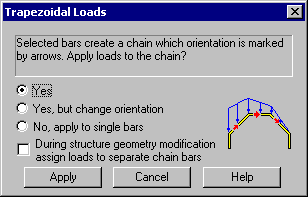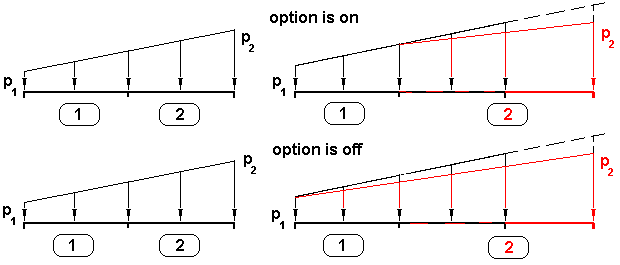You can define a trapezoidal load that is applied to several bars forming a chain of bars. To do this:
- In the Trapezoidal load dialog, define the parameters of the load, such as the beginning and end values, the direction, and so on.
- In the Load definition dialog, select (a chain of) bars to which the defined load will be applied, using either method:
- Enter the bar numbers in the Apply to field and click Apply.
- Highlight the bars in the drawing area (their numbers display in the Apply to field and click Apply.
After clicking Apply, the following dialog displays.

In this dialog, you can define the way a load is applied to selected structure bars. At the top of the dialog, a question asks whether the load is to be applied to a user-defined chain of bars. The following are the possible answers to the question, which are also displayed as diagrams on the right side of the dialog:
- Yes (retain orientation) - The load is applied to the user-defined chain of bars and the orientation of the chain represented by arrows (specifying the beginning and end of the chain) is retained.
- Yes, but change orientation - The load is applied to the user-defined chain of bars, but the orientation of the chain represented by arrows (specifying the beginning and end of the chain) is changed.
- No, apply to single bars - The trapezoidal load is applied to single bars in the chain.
The During structure geometry modification assign loads to separate chain bars option is at the bottom of the dialog. Select this option when after a load is applied, the geometry of the structure bars subjected to action of the trapezoidal load changes or the values of the trapezoidal load at the beginning or end of a chain of bars (load values p1or p2) change.
When the During structure geometry modification assign loads to separate chain bars option is selected, the chain of bars is treated as separate structure bars when modifying structure bars. When the option is cleared, modifying structure bars treats the chain of bars as 1 super bar. It causes the entire load to be calculated again for the new superbar geometry.
The following image shows schematically how the During structure geometry modification assign loads to separate chain bars option works (for the trapezoidal load (2p)). The top of the image shows the case when the option is selected; whereas, the bottom shows the case when the option is cleared.

Clicking Apply, applies the trapezoidal load to the selected bars.